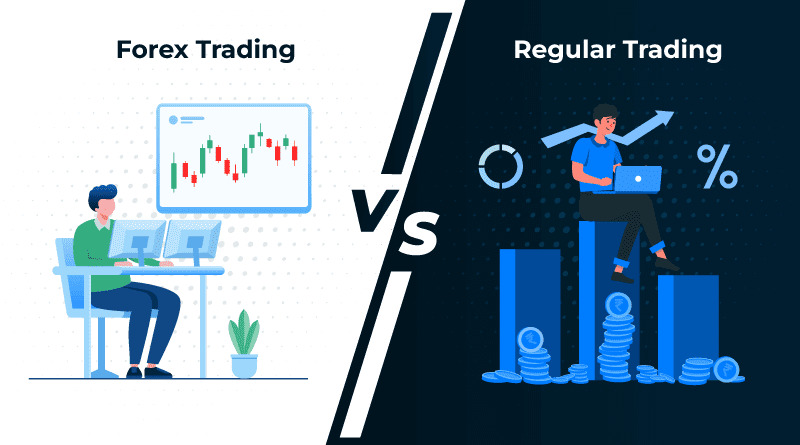When it comes to investing, Forex trading and stock trading are two popular options. Both have unique opportunities and risks. Understanding the differences between them can help you decide which path to take. In this article, we will explore what each trading method is, their pros and cons, and tips for success in both.
What is Forex Trading?
Forex trading, short for foreign exchange trading, involves buying and selling currencies. It is the largest financial market in the world, with over $6 trillion traded every day. The Forex market operates 24 hours a day, five days a week, and includes major currency pairs like EUR/USD (Euro to US Dollar) and GBP/USD (British Pound to US Dollar).
How Does Forex Trading Work?
In Forex trading, you trade currency pairs. When you buy a pair, you buy one currency and sell another. For example, if you think the Euro will become more valuable than the US Dollar, you would buy the EUR/USD pair. If the Euro increases in value, you can sell it for a profit.
Most Forex trading happens through brokers, who provide platforms and tools to trade. Traders can use leverage, which allows them to control larger amounts of money with a smaller investment, but this can also increase risks.
Advantages of Forex Trading
- High Liquidity: The Forex market is very liquid, meaning you can easily buy and sell currencies without significantly affecting their prices.
- 24/5 Market: You can trade at any time since the Forex market is open all day, five days a week.
- Leverage: Many brokers offer leverage, allowing you to control larger positions with less money.
- Diverse Options: You can choose from many currency pairs, giving you various trading strategies.
Disadvantages of Forex Trading
- High Risk: Leverage can lead to large losses as well as large gains. You can lose more than your initial investment.
- Complexity: The Forex market can be complicated, with many factors affecting currency values, like economic news and global events.
- Less Regulation: The Forex market is less regulated compared to other markets, which can increase risks, especially with some brokers.
What is Stock Trading?
Stock trading involves buying and selling shares of companies. When you buy a stock, you own a piece of that company. The value of your investment can go up or down based on how well the company is doing and market conditions. The stock market is usually open during specific hours, depending on the exchange, like the New York Stock Exchange (NYSE).
How Does Stock Trading Work?
In stock trading, you buy shares in a company hoping that it will grow and make profits. If the company does well, the stock price may rise, allowing you to sell your shares for a profit. If the company struggles, the stock price may drop, leading to losses.
Advantages of Stock Trading
- Ownership: Buying a stock means you own part of the company, which can be rewarding if the company performs well.
- Dividends: Many companies pay dividends, giving you a regular income on top of any profit from selling the stock.
- Regulation: The stock market has strict regulations, providing some safety for investors.
- Variety of Strategies: Investors can choose from different trading strategies, like long-term investing or day trading.
Disadvantages of Stock Trading
- Market Hours: The stock market is only open during certain hours, which may not work for everyone.
- Volatility: Stock prices can change quickly, influenced by earnings reports, market trends, and economic conditions.
- Research Needed: Successful stock trading often requires a lot of research and analysis.
Key Differences Between Forex Trading and Stock Trading
1. Market Hours
Forex trading is available 24 hours a day, five days a week, allowing traders to participate at their convenience. In contrast, stock trading is limited to specific hours when exchanges are open.
2. Market Size and Liquidity
The Forex market is much larger and more liquid than the stock market. This high liquidity allows for quicker buying and selling, which is especially useful for day traders.
3. Leverage
Both Forex trading and stock trading offer leverage, but it is usually more significant in the Forex market. While leverage can increase profits, it also increases risks.
4. Regulation
The stock market is more regulated than the Forex market, offering more security for investors. In the Forex market, regulations can differ by country and broker.
5. Types of Assets Traded
In Forex trading, you trade currency pairs, while in stock trading, you buy and sell shares of individual companies. This basic difference shapes the strategies used in each market.
Which One Should You Choose?
Choosing between Forex trading and stock trading depends on several factors, including your financial goals, risk tolerance, and trading style. Here are some things to think about:
1. Risk Tolerance
If you are comfortable with higher risks and the potential for quick gains or losses, Forex trading might appeal to you. If you prefer more stable investments with long-term growth, stock trading could be better.
2. Time Commitment
Forex trading requires a lot of time and attention since it’s open all day. If you can dedicate time to monitor the market, this may be a good fit. If you have a busy schedule and prefer specific trading hours, stock trading might suit you better.
3. Investment Goals
Think about what you want to achieve. If you want quick profits and can handle the Forex market’s ups and downs, it might be worth exploring. If you’re more interested in long-term growth and dividends, stock trading could be the way to go.
4. Interest in Analysis
Both types of trading need analysis, but the focus is different. If you like studying economic data, you might enjoy Forex trading. If you prefer analyzing companies and their performance, stock trading could be more your style.
Tips for Success in Forex Trading and Stock Trading
1. Educate Yourself
No matter which option you choose, education is key. Spend time learning about the market, strategies, and analysis techniques to improve your chances of success.
2. Start Small
When starting out in either Forex trading or stock trading, begin with a small amount of money. This allows you to gain experience without risking a lot.
3. Develop a Trading Plan
Create a plan that outlines your strategy, how you will manage risk, and your goals. This will help you stay focused.
4. Stay Updated
Keep track of market news and trends. Economic indicators and global events can impact both Forex trading and stock trading.
5. Practice Patience and Discipline
Both markets can be volatile, and emotions can lead to poor decisions. Stay patient and stick to your trading plan.
Here’s a simple table that outlines the key differences between Forex trading and stock trading:
| Feature | Forex Trading | Stock Trading |
|---|---|---|
| Market Hours | 24 hours a day, five days a week | Specific hours (e.g., 9:30 AM – 4 PM EST) on trading days |
| Market Size | Largest financial market (over $6 trillion daily) | Smaller market compared to Forex |
| Assets Traded | Currency pairs (e.g., EUR/USD, GBP/USD) | Shares of publicly traded companies |
| Liquidity | High liquidity, easy to enter/exit trades | Moderate liquidity; varies by stock |
| Leverage | High leverage available (up to 100:1 or more) | Lower leverage (usually 2:1 to 4:1) |
| Regulation | Less regulated; varies by country | Highly regulated in most countries |
| Risk Level | High risk due to leverage and volatility | Moderate risk, can be volatile but more stable over time |
| Analysis Methods | Focus on economic indicators, geopolitical events | Focus on company performance, financial reports, and market trends |
| Trading Strategies | Day trading, scalping, swing trading | Day trading, long-term investing, value investing |
| Dividends | No dividends | Possible dividends from companies |
| Initial Investment | Often lower initial investment required | Varies; can be higher depending on stock price |
| Emotional Impact | Can be more intense due to rapid price changes | Less intense, but still influenced by market conditions |
| Learning Curve | Requires understanding of multiple currencies and global events | Requires knowledge of companies and market analysis |
Here’s a table comparing Forex trading and stock trading with a focus on profit and loss scenarios:
| Feature | Forex Trading | Stock Trading |
|---|---|---|
| Profit Scenario | – Buy EUR/USD at 1.1000 and sell at 1.1050. – Profit of 50 pips (or $500 for 1 standard lot). | – Buy 100 shares of Company X at $50. – Sell at $55. – Profit of $500. |
| Loss Scenario | – Buy GBP/USD at 1.3000 and sell at 1.2950. – Loss of 50 pips (or $500 for 1 standard lot). | – Buy 100 shares of Company Y at $40. – Sell at $35. – Loss of $500. |
| Leverage Impact | – Using 100:1 leverage, $1,000 can control $100,000. – A 1% move results in $1,000 profit/loss. | – Using 2:1 leverage, $1,000 can control $2,000 worth of stock. – A $1 move results in $100 profit/loss. |
| Volatility Impact | – Currency pairs can swing quickly; a sudden news event can lead to large profits or losses. | – Stock prices can be influenced by earnings reports, but generally, changes are less volatile than currencies. |
| Trade Execution Speed | – High-speed execution is crucial; trades can turn quickly. | – Execution speed matters, but stock prices tend to move more gradually than currency prices. |
| Holding Period | – Often short-term; day traders close positions daily. – Long-term holds are less common due to volatility. | – Can vary from day trading to long-term investing (months or years). |
| Emotional Impact | – High-stress environment; rapid changes can lead to emotional decisions. | – Moderate stress; longer holding periods can help manage emotions better. |
Conclusion
Both Forex trading and stock trading offer different opportunities and challenges. Understanding these differences can help you choose the right path based on your goals, risk tolerance, and trading style. Whether you navigate the fast-paced world of Forex trading or the structured environment of stock trading, education, discipline, and a clear strategy are essential for success. Take your time to learn and find the approach that fits best with your investment goals.

